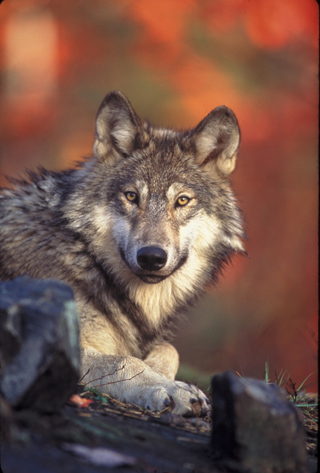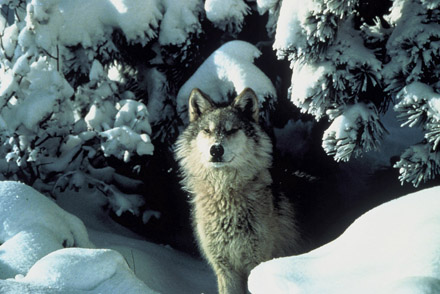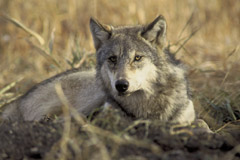Navigation
Northern Rocky Mountain Gray Wolf Receives Renewed Protection
On August 5, 2010, a U.S. District court overturned the U.S. Fish and Wildlife Service’s (FWS) decision to remove gray wolves in the Northern Rockies from the endangered species list. The court sided conservation organizations that sued to restore federal protections.
 |
| Gray wolf. Photograph by Gary Kramer courtesy of US Fish and Wildlife Service (FWS) |
On August 5, 2010, a U.S. District court overturned the U.S. Fish and Wildlife Service’s (FWS) decision to remove gray wolves in the Northern Rockies from the endangered species list. The court sided conservation organizations that sued to restore federal protections.
 |
| Gray wolves in Montana and Idaho were ordered returned to the nation's endangered species list. A video provided by the U.S. Fish & Wildlife Service is available at the bottom of the page. |
One immediate effect of this court ruling will be to cancel a second wolf hunting season in Montana and Idaho, which was set to begin this fall and would have decreased the population to even lower levels. State agencies will still be able to manage wolves, including removing problem wolves implicated in livestock conflicts or causing unnatural declines in game species.
 |
| Gray wolf. Photograph by Tracy Brooks Mission courtesy of US Fish and Wildlife Service (FWS) |
“This decision is a significant victory for wolves, for the integrity of the Endangered Species Act, and for all Americans who care deeply about conservation, said Rodger Schlickeisen, president of Defenders of Wildlife. “We all need to work together to craft responsible state management plans for wolves that allow for healthy, interconnected wolf populations now and in the future. For that to happen, regional recovery goals will need to be updated based on the best available peer reviewed science.
 |
| Gray wolf. Photograph by John and Karen Hollingsworth courtesy of US Fish and Wildlife Service (FWS) |
Assistant Secretary of the Interior for Fish and Wildlife and Parks Tom Strickland on August 5, 2010 issued the following statement regarding a decision in U.S. District Court on the Northern Rocky Mountain gray wolf population, Threatened and Endangered Species: Achieving Recovery and Preventing Extinction:
“For more than 15 years, the U.S. Fish and Wildlife Service, state wildlife agencies, tribes, conservation organizations, ranchers and other landowners have worked hard to recover gray wolves in the Northern Rocky Mountains. Our collective efforts have brought this population to the point where it no longer requires Endangered Species Act protection.
“Despite this extraordinary success, today’s ruling means that until Wyoming brings its wolf management program into alignment with those of Idaho and Montana, the wolf will remain under the protection of the Endangered Species Act throughout the northern Rocky Mountains. Since wolves in the Northern Rocky Mountains are now again subject to ESA protection, in the days ahead we will work closely with Idaho and Montana to explore all appropriate options for managing wolves in those states.
“Reintroduced from Canada, in the mid-1990s, to remote areas of central Idaho and Yellowstone National Park, the wolf population flourished and reached sustainable recovery levels as early as 2002. It has continued to grow and has now far surpassed these recovery plan targets.
“The Service’s decision to delist the wolf in Idaho and Montana reflected the strong commitments from the states of Idaho and Montana to manage gray wolves in a sustainable manner. Today’s ruling makes it clear this wolf population cannot be delisted until the State of Wyoming has instituted an adequate management program, similar to those of Idaho and Montana.
“In the meantime, we will continue to work closely with the states, tribes, conservation organizations, and ranchers and other landowners to manage wolves and ensure the species continues to thrive and coexist with livestock, other wildlife populations, and people.”
Background:
Wolves were eradicated from the region by the 1930s as part of an overall campaign to eliminate many of the native predators. With the adoption of the Endangered Species Act in 1973, efforts began to restore the Northern Rockies wolf population. Wolves dispersing across the Canadian border into northern Montana in the 1970s and 1980s were the first to return to their historic habitat in the region. By 1995, that population had grown to 60 - 70 wolves. To expedite wolf recovery, in 1995 and 1996 the US Fish and Wildlife Service captured 66 wolves from Canada and released them in central Idaho and Yellowstone National Park. Since that time, wolf numbers have increased to approximately 2,000 wolves in 2009, the same number that many biologists have estimated would be necessary for maintaining a recovered wolf population. However, that same year, Idaho and Montana initiated hunting seasons which reduced the wolf population down to 1650 wolves by the end of 2009.
The information for this article was provided by the U.S. Fish and Wildlife Service and the Defenders of Wildlife 5 August 2010.
Note:
Defenders of Wildlife is dedicated to the protection of all native animals and plants in their natural communities.
Gray wolves in Montana and Idaho were ordered returned to the nation's endangered species list. This video provided by the U.S. Fish & Wildlife Service is in the public domain.
Search
Latest articles
Agriculture
- World Water Week: Healthy ecosystems essential to human health: from coronavirus to malnutrition Online session Wednesday 24 August 17:00-18:20
- World Water Week: Healthy ecosystems essential to human health: from coronavirus to malnutrition Online session Wednesday 24 August 17:00-18:20
Air Pollution
- "Water and Sanitation-Related Diseases and the Changing Environment: Challenges, Interventions, and Preventive Measures" Volume 2 Is Now Available
- Global Innovation Exchange Co-Created by Horizon International, USAID, Bill and Melinda Gates Foundation and Others
Biodiversity
- It is time for international mobilization against climate change
- World Water Week: Healthy ecosystems essential to human health: from coronavirus to malnutrition Online session Wednesday 24 August 17:00-18:20
Desertification
- World Water Week: Healthy ecosystems essential to human health: from coronavirus to malnutrition Online session Wednesday 24 August 17:00-18:20
- UN Food Systems Summit Receives Over 1,200 Ideas to Help Meet Sustainable Development Goals
Endangered Species
- Mangrove Action Project Collaborates to Restore and Preserve Mangrove Ecosystems
- Coral Research in Palau offers a “Glimmer of Hope”
Energy
- Global Innovation Exchange Co-Created by Horizon International, USAID, Bill and Melinda Gates Foundation and Others
- Wildlife Preservation in Southeast Nova Scotia
Exhibits
- Global Innovation Exchange Co-Created by Horizon International, USAID, Bill and Melinda Gates Foundation and Others
- Coral Reefs
Forests
- NASA Satellites Reveal Major Shifts in Global Freshwater Updated June 2020
- Global Innovation Exchange Co-Created by Horizon International, USAID, Bill and Melinda Gates Foundation and Others
Global Climate Change
- It is time for international mobilization against climate change
- It is time for international mobilization against climate change
Global Health
- World Water Week: Healthy ecosystems essential to human health: from coronavirus to malnutrition Online session Wednesday 24 August 17:00-18:20
- More than 400 schoolgirls, family and teachers rescued from Afghanistan by small coalition
Industry
- "Water and Sanitation-Related Diseases and the Changing Environment: Challenges, Interventions, and Preventive Measures" Volume 2 Is Now Available
- Global Innovation Exchange Co-Created by Horizon International, USAID, Bill and Melinda Gates Foundation and Others
Natural Disaster Relief
- STOP ATTACKS ON HEALTH CARE IN UKRAINE
- Global Innovation Exchange Co-Created by Horizon International, USAID, Bill and Melinda Gates Foundation and Others
News and Special Reports
- World Water Week: Healthy ecosystems essential to human health: from coronavirus to malnutrition Online session Wednesday 24 August 17:00-18:20
- STOP ATTACKS ON HEALTH CARE IN UKRAINE
Oceans, Coral Reefs
- World Water Week: Healthy ecosystems essential to human health: from coronavirus to malnutrition Online session Wednesday 24 August 17:00-18:20
- Mangrove Action Project Collaborates to Restore and Preserve Mangrove Ecosystems
Pollution
- Zakaria Ouedraogo of Burkina Faso Produces Film “Nzoue Fiyen: Water Not Drinkable”
- "Water and Sanitation-Related Diseases and the Changing Environment: Challenges, Interventions, and Preventive Measures" Volume 2 Is Now Available
Population
- "Water and Sanitation-Related Diseases and the Changing Environment: Challenges, Interventions, and Preventive Measures" Volume 2 Is Now Available
- "Water and Sanitation-Related Diseases and the Changing Environment: Challenges, Interventions, and Preventive Measures" Volume 2 Is Now Available
Public Health
- Honouring the visionary behind India’s sanitation revolution
- Honouring the visionary behind India’s sanitation revolution
Rivers
- World Water Week: Healthy ecosystems essential to human health: from coronavirus to malnutrition Online session Wednesday 24 August 17:00-18:20
- Mangrove Action Project Collaborates to Restore and Preserve Mangrove Ecosystems
Sanitation
- Honouring the visionary behind India’s sanitation revolution
- Honouring the visionary behind India’s sanitation revolution
Toxic Chemicals
- "Water and Sanitation-Related Diseases and the Changing Environment: Challenges, Interventions, and Preventive Measures" Volume 2 Is Now Available
- Actions to Prevent Polluted Drinking Water in the United States
Transportation
- "Water and Sanitation-Related Diseases and the Changing Environment: Challenges, Interventions, and Preventive Measures" Volume 2 Is Now Available
- Urbanization Provides Opportunities for Transition to a Green Economy, Says New Report
Waste Management
- Honouring the visionary behind India’s sanitation revolution
- Honouring the visionary behind India’s sanitation revolution
Water
- Honouring the visionary behind India’s sanitation revolution
- Honouring the visionary behind India’s sanitation revolution
Water and Sanitation
- Honouring the visionary behind India’s sanitation revolution
- Honouring the visionary behind India’s sanitation revolution

